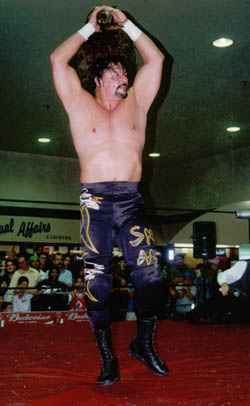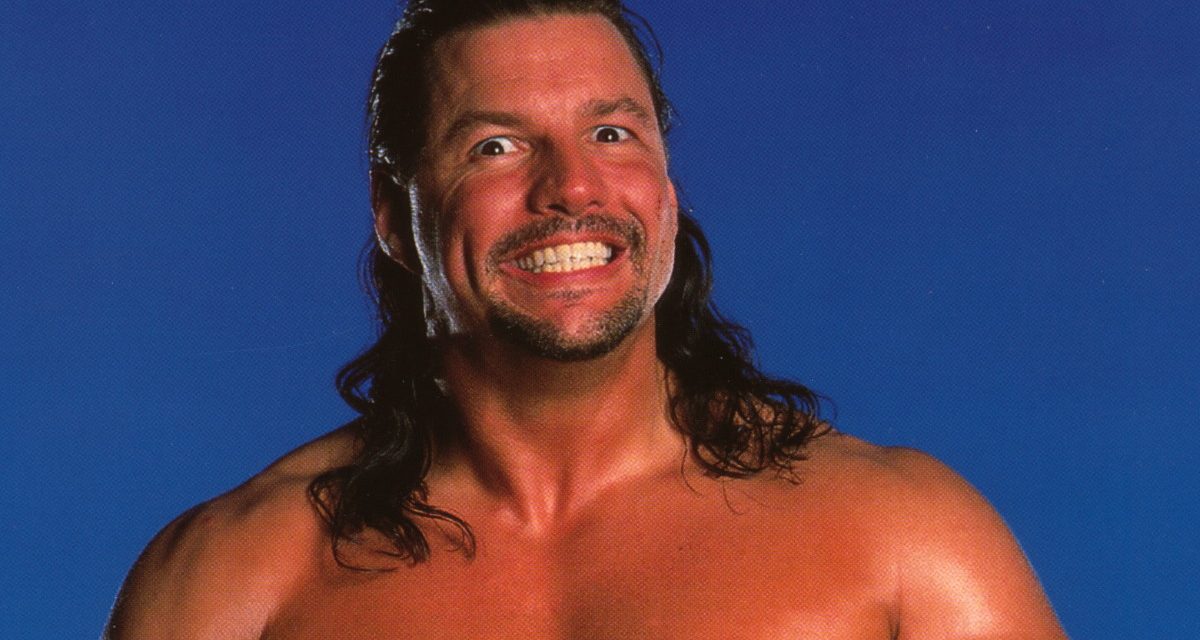In a crowded room, adopted as a crude changing area for the wrestlers participating in the Titans in Toronto wrestling show, Al Snow has just returned from the ring.
Even as he tries to dry himself off, fans blatantly step forward pleading for an autograph and picture. Where others would boldly refuse and demand some privacy, Snow waves his signature to paper and grins for the camera flash.
But it should come as no surprise. This is Al Snow, a 20-plus-year veteran of professional wrestling who still knows what it means to be a professional.

Al Snow with Head in hand rouses the crowd at the Titans in Toronto show. Photo by Corey David Lacroix
On a weekend where the faithful have gathered to pay their respects to those who built the industry known as professional wrestling, it seemed only appropriate that one of today’s modern veteran stars would be in attendance.
Even as he rushes to change into his street clothes and catch his flight home, Snow is conscious of the past and the role it has played in his own success.
“It’s very important to respect where the business originated from and for those who gave their hearts and souls to enable you, the fans, to still enjoy one of the few true American art forms called professional wrestling,” said Snow to SLAM! Wrestling. “It’s important to pay homage to those same people who created a business that allowed me and other people to pursue a passion and perform in front of the fans and allow us to make a good living, probably a greater living that what those guys ever did.”
It is a glaring contrast to see how fortunate he is to be a professional wrestler in the era of mass media, in which the WWE has taken full advantage of, elevating its sports entertainment genre to unprecedented world wide recognition.
As anxious fans line up to have their picture taken with Snow in the ring, the very legends of the ring Snow pays tribute to mingle about near ringside, anonymous to the vast majority in attendance. They have never wrestled on a pay per view, never hosted a reality TV show, never had their matches immortalized onto DVD. Deserving as they may be, time himself has denied them, while giving Snow so much to be grateful for.
“I very aware of it,” remark Snow. “I feel that I am very fortunate, very lucky. That sounds kinda ass kissey, but it’s really the truth. I’ve gotten to do what I’ve had a passion to do for 22 years. I tell my own children: pursue what you feel passionate about. You can do anything you want to do if you want to do it bad enough, especially if it’s something you feel passionate about. It’s like the old saying, if you do what you love to do then you’ll never work a day in your life. For me, nothing has ever been more true.”
To hear Snow speak about his love for wrestling is to step into the past when he first entered the wrestling business. It was a grappler by the name of Big Jim Lancaster (real name Jim Painter) who indoctrinated the youngster who would go on to assume a variety of WWE character gimmicks: Avatar, Leif Cassidy, Shinobi. None would endure.
It was not until his tenure in ECW that Snow would finally appear on the wrestling radar, talking to a mannequin’s head with the words ‘Help Me’ printed backwards on his forehead. A cult following ensued, and with it, a return ticket to WWE and fame.
But make no mistake, it was passion that got him where he is, passion that was passed on to him from his wrestling elders. “When I was brought into this business, I was evaluated based on my desire to be in it,” said Snow. “For my predecessors, it (wrestling) was everything and anything to them. It was their life, it was in their blood. They didn’t make a ton of money; they did it for the sheer passion of doing it. They protected this business with every fiber of their being because they knew if they let it slip, that not only would they suffer but everyone else would suffer and their families would suffer. They wanted to make sure that you, coming into this business, felt as passionate about this business as they did.”
Fortunate as Snow was to receive the proper mentoring that has guided him to prosperity, the same cannot be said for the next generation. With few elder statesmen present to guide up-and-coming grapplers on the proper foundations of wrestling, the new breed of professional wrestler is missing vital indoctrination. Where the basics of ring psychology, storytelling abilities, and following locker room protocol were mandatory, now are but an anomaly maintained by a select few. “It’s true,” said Snow bluntly. “There’s not as much of that now as there was when I broke into the business. The etiquette, standards and set rules of behavior were there from the start from the carny days to keep this business what it was.”
But wrestling is not what it used to be. Kayfabe is dead and fans are now more discriminating when it comes to what they want to see in the ring. What has not changed, according to Snow, is the desire of fans to become emotionally attached to a great wrestling match.
“The bottom line is the art form still remains the same and that is regardless of what you do or how fast you do it. Ultimately, you want to create an emotional connection and therefore, a strong emotional response via your actions and by telling your story.”
“I don’t think that happens quite as often as it should anymore,” Snow went on. “Somebody needs to teach these guys to not call things for a ‘pop’. A ‘pop’ is misunderstood; it used to be something that would make the crowd ‘pop up’, which was basically something so emotionally strong that they (audience) basically had an orgasm.”
“They don’t do that anymore. When they call a finish, they don’t call a finish with the understanding of making people so happy that they stand on their feet and cheer, or making them so angry that they want to storm the ring and cut your throat. That is what is missing these days.”
What is in abundance these days are lightweight wrestlers who use death defying, lucha libre inspired highspots to win over the fans. While no one may dispute the athleticism and coordination need to perform such aerials, what Snow makes abundantly clear is that the reaction from the audience is momentary, not emotional.
“A highspot is not just a series of moves that up the action,” he explained. “A highspot is a highspot of emotion that raises the level to further the story and get the ultimate reaction at the end. They’re not teaching that because I don’t think there are guys around who know how to teach that. ”
“It’s not doing things for that momentary ‘pop’ or ‘ooh’ or ‘aahh’. That’s a reaction you get when you’re watching fireworks and let’s face it, with that kind of reaction, you can watch fireworks once or twice a year and you’re not missing anything and that’s because there is no emotional connection. It’s just a fascination.”
Snow’s emotional connections extend beyond what he does in the ring. As a trainer, he assumes a maternal role in nurturing those who tutor under him, vigilant in passing down what was given to him.
“I train people the way I was trained and I take it very seriously,” Snow said. “I look at it as my way of giving back to his business and I’m very protective to that. When I call them (students) my kids it’s because the guy who trained me called me his kid and was responsible for me. To this day, old timers will call him up and say ‘Hey, did you see what your kid did on TV?’ Twenty-two years later, I’m still carrying his reputation around.”
As for Snow’s reputation, he may very well come to pass as a wrestler who possesses intimate knowledge that is fading with the passage of time. But he is adamant that the spectacle of professional wrestling will live on, upheavals in tow.
“I fully understand why the style of wrestling is the way it is nowadays. The business will survive, there’s nothing or no one that’s bigger than the business.”
RELATED LINK

